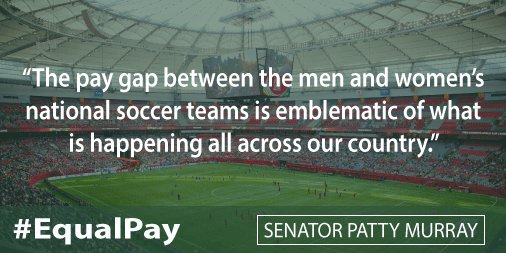The U.S. national women’s soccer team has won far more championships than the U.S. men’s team. So why are they paid less?
By Liza Bayless
Yes! Magazine, Aug 08, 2016 —

Yes! llustration by Jennifer Luxton
Four years after suffering a heartbreaking overtime loss to Japan in the final match of the 2011 FIFA Women’s World Cup, the U.S. national team took the field in Vancouver, British Columbia, for a rematch.
It was a game of redemption, and it would become much more.
Just minutes into the game, U.S. midfielder Carli Lloyd, who had infamously missed a crucial penalty kick in that previous meeting, emerged from nowhere to pick up a cross. As 53,341 fans held their breath, she rocketed it to the back of Japan’s net. Not yet a quarter through, the U.S. team was up two more goals. Then, in the 16th minute, Lloyd decisively chipped the ball across the stadium, from a distance longer than half an American football field, and over the Japanese goalkeeper’s head. It was Lloyd’s third goal of the game, and the fastest hat trick in World Cup history—men’s or women’s. The U.S. team’s 5-2 victory in 2015 earned it a third Cup title, crowning it the most winning team of women’s soccer. It was a game of redemption, and it would become much more.
In the wake of the win, and with reports surfacing that the final game had been the most-watched soccer match in U.S. history with a total of 26.7 million viewers, people suddenly seemed to want to talk about a female athletic team. Thousands of fans flooded New York City’s streets for a ticker-tape parade honoring the victory. Sports Illustrated featured the team in a series of 25 alternate covers, which was significant considering that, as of 2011, women had appeared on less than 5 percent of the weekly magazine’s covers, not counting swimsuit editions. The players made the talk show rounds and received invites to the White House. It was all cause for celebration and a symbol of how far women’s sports had come, but all this good news exposed a darker reality.

Carli Lloyd and teammates celebrate a goal during the 2012 Olympics. Photo by Christopher Johnson/Flickr.
As the players of the U.S. women’s national team sat for interviews and received more attention, controversial information came to light. The turf fields they had played on throughout almost the entire tournament, including the final, were not standard in professional soccer. Although a cheaper alternative to grass, turf has a hard surface and its plastic materials make ball control more difficult, creating dangerous playing conditions. In at least the past two years, the U.S. men’s national team has not played a single game on turf, while the women have been playing on it for almost a third of their games. Before the Cup, a handful of players, including prominent forward Abby Wambach, had filed a gender discrimination complaint against FIFA—the international governing body of soccer—and the Canada Soccer Association. They had dropped the lawsuit, however, allegedly due to threats of individual suspensions and cancellation of the tournament.
Another matter was also gaining national interest: the disparity of pay between male and female players. The U.S. women’s national team collectively earned $2 million for their 2015 World Cup win. The U.S. men’s national team—who has not made it past the quarterfinals of a World Cup in more than eight decades, and has never won—earned $9 million for their loss in the round of 16 at the 2014 Men’s World Cup in Brazil. Germany, the winning team, collected $35 million.
The women’s team brought in more revenue in the 2016 fiscal year and is also projected to outperform the men in revenue and profit in 2017.
FIFA adamantly defends the gap in prize money as a product of the difference in revenues from the two tournaments. But the organization, which was involved in a massive corruption scandal last year, has historically invested comparatively little in the women’s game. Sepp Blatter, FIFA’s former president who once referred to himself as “the godfather of women’s football,” suggested in 2004 that female players could boost the popularity of the game by wearing tighter clothing to create a more “female aesthetic.” In 2014, he admitted that there is resistance to allowing women into the FIFA governance circle.
Even within the U.S. Soccer Federation, which employs the U.S. women’s national team and is perhaps the organization most supportive of global women’s soccer development, there is a substantial gap. The women’s team brought in more revenue in the 2016 fiscal year (granted, a World Cup year) and is also projected to outperform the men in revenue and profit in 2017, when neither team is playing a World Cup. U.S. Soccer expects they will bring in almost twice as much as the men—$17.6 million versus $9 million. And yet the federation pays its female players $1,350 for winning an exhibition match while the men receive up to $17,625 for doing the same. For a loss, men receive $5,000. Women receive nothing. For making the World Cup roster, a male player makes $68,750 while a woman makes $15,000.
#equalplayequalpay #beyourbestyou
The women do receive a base salary of $72,000 for playing on the national team and some benefits that the men do not. However, if both teams were to win all 20 exhibition games—the matches they play outside of tournaments—in a year, a female player would be paid $99,000 total (including base salary) while a male player would be paid $263,320. Additionally, sponsors compensate men hundreds of dollars more per game appearance.
“These women are playing the same game, and they are severely undervalued as compared to the men,” says Veronica Arreola, assistant director of the Center for Research on Women and Gender at the University of Illinois at Chicago.
With new public support and interest coming from millions of Americans as a result of their recent World Cup victory, five of the most distinguished players—Lloyd, Alex Morgan, Hope Solo, Becky Sauerbrunn, and Megan Rapinoe—brought a wage-discrimination complaint against the U.S. Soccer Federation with the Equal Employment Opportunity Commission, the government agency enforcing federal discrimination laws. Their attorney, Jeffrey Kessler, has said this is the strongest case of discrimination against women in sports he has seen.
Their attorney, Jeffrey Kessler, has said this is the strongest case of discrimination against women in sports he has seen.
“We think it’s time for [our] employers to truly address the inequality and do not only what is fair, but what is right,” star forward Morgan wrote on Instagram in an announcement of her participation in the lawsuit. “We decided to do this for all the little girls across the country and around the world who deserve to have a voice. If we don’t leverage the voice we have, we are letting them down.”
While there has been much support for the women in this fight—including from Hillary Clinton, and the pioneer of equal pay in tennis, Billie Jean King—there has also been significant pushback. Much of the disagreement comes from the metrics used to judge fair pay, since the payment systems for the men and women differ greatly.
One argument is that the women actually benefit from salaried positions that cover injuries and maternity leave, while the men are in the precarious positions of receiving national team payment only for games they suit up for. This neglects the fact that men are paid living, if not very comfortable, wages for playing with Major League Soccer (MLS) in the U.S. In contrast, the National Women’s Soccer League (NWSL) currently has a salary minimum of $7,200—well below the U.S. poverty threshold—and an average salary of $32,000. Many of those players, who compete at a professional level, live with host families because they can’t afford apartments in the cities they play for.

Fans hold sign at a Chicago Red Stars game referencing lawsuit for equal pay. Photo by John Dunlevy/Flickr.
“In the current economic environment, it’s not at all unfair that female athletes make less than their male counterparts,” wrote Lizzie Crocker for The Daily Beast. “It’s simply a matter of supply and demand.” U.S. Soccer agrees, and has said that the wage lawsuit is based on figures from an outlier year, when women’s revenues were abnormally higher. This is true; historically, the men’s team has brought more money to the U.S. Soccer Federation.
Investments in their development are much lower even when the potential for success and revenue generation is there.
But it’s not actually that simple, writes Travis Waldron of The Huffington Post. “The revenue-based argument might make sense if international soccer existed in a market in which sportsmen and women have been afforded the same opportunities to succeed. But it doesn’t.” Waldron argues that women’s programs have never even had the chance to generate the same consistent revenues as men’s because soccer federations and the media have never afforded them the opportunity.
And this, he explains, is because of deep-rooted and socialized beliefs that women’s sports are less interesting. Therefore, investments in their development are much lower even when the potential for success and revenue generation is there, as demonstrated by the 2015 World Cup’s success.
These beliefs are not innate truths, but instead “relics of a past era,” writes Purdue University’s Associate Professor of American Studies Cheryl Cooky. She argues that too many of the claims that male athletes deserve more—in media coverage, pay, investment—are “justified with a casual assumption” that men are just inherently doing the job better, and more entertainingly, when it comes to sports.
“While Carli Lloyd is a fabulous women’s soccer player, and she should be celebrated as a very talented women’s soccer player, she couldn’t carry Clint Dempsey’s sweat towel in a game,” D.C. McAllister wrote for The Federalist, referring to one of the top U.S. men’s players.
Sports Illustrated writer Andy Benoit tweeted last year that women’s sports are less entertaining than men’s. When someone challenged him with an exciting clip of the Women’s World Cup, Benoit clarified his point: “Not women’s soccer … women’s sports in general not worth watching,” he wrote on Twitter. Though Benoit later deleted the posts and faced harsh criticism that provoked a public apology, these comments were not just representative of some small, outlying population. Benoit’s thoughts on women’s athletics reflect what sports media teaches viewers every day.
Benoit’s thoughts on women’s athletics reflect what sports media teaches viewers every day.
Despite the ever-increasing involvement in women’s athletics, representation of this on television has remained astonishingly low. A study, co-authored by Cooky, found that in 2014, 3.2 percent of local networks’ televised sports coverage was dedicated to women. ESPN’s SportsCenter did worse in the same year, covering women a mere 2 percent of the time. When Fox Sports won the bid for rights to air the live women’s World Cup games, ESPN delegated coverage of the matches to its platform for women, espnW, and the CBS Sports website listed news about the Cup under its “more” tab.
“America’s leaders in sports coverage are giving us a high-production-value education in what’s important in sports,” Evelyn Shoop wrote for The Daily Beast. “And it almost completely excludes women.”

Alex Morgan prepares for a shot in a game against Costa Rica in July. Photo by Sandy H./Flickr.
Perhaps by focusing so much on the economics, it is easy to lose sight of deeper issues. “Sports are fictive and frighteningly real,” writes Jennifer Doyle, a professor at the University of California, Riverside, in GLQ Journal. They tell a story beyond what is happening on the field or the arena, one that reflects something bigger, often something sinister, about where society stands at the moment. They are not just games.
The framing and language used in rare news stories about athletes who are women is indicative of deeply ingrained mentalities. Interviewing Serena Williams after her Wimbledon win, a reporter commented, “There will be talk about you going down as one of the greatest female athletes of all time.” Williams responded, “I prefer the words ‘one of the greatest athletes’ of all time.”
The idea that these are two categories—athletes and female athletes—meriting different worth is what the U.S. women’s national team has decided to combat.
In June, a court validated the U.S. women’s national team’s current pay agreement with the U.S. Soccer Federation. This means that the pursuit of equal pay is on hold until late December, when their contract expires and the players can attempt to renegotiate.
Support for this lawsuit sends a message about what’s happening with gender discrimination countrywide.
In the meantime, Senator Patty Murray of Washington, the state’s first female senator, recently introduced a nonbinding resolution within the Senate that asks the U.S. Soccer Federation to end inequity and treat the women’s team with the respect it deserves. It passed unanimously. Murray has said that support for this lawsuit sends a message about what’s happening with gender discrimination countrywide.

Senator Patty Murray ✔@PattyMurray The #wagegap even extends to Olympic gold medalists & World Cup champions playing for the U.S. women’s soccer team. 1:57 PM – 26 May 2016
So for now, the team, headed by the five players taking legal action, will focus on achieving a fifth Olympic gold medal. The Rio games will provide a global platform for their message: “Equal Play, Equal Pay,” a slogan printed on t-shirts and displayed on their widely followed social media accounts. The setting will also provide a space for fans to watch the team a year after the World Cup, reminding the media and the governing bodies of soccer that support for these women both on and off the field is lasting.
“We’re on the right side of history here,” said Sauerbrunn in an interview with espnW. “We fight through every adversity we have. So it shouldn’t be a surprise that we are willing to fight this issue until we have exhausted every single avenue.”
And while their voices may be the most prominent, they are not alone. Female athletes all over the world are struggling to succeed: Just in the soccer world, Costa Rica has yet to pay its players the bonuses they won for entrance into last year’s World Cup; Colombian players have been suspended for speaking out about going for long periods unpaid by their federation; and the Australian team has gone on strike to protest yearly salaries of less than $15,000 USD.
When asked by an espnW interviewer about what the players want to achieve with what has become known as the “Equal Pay” lawsuit, Lloyd’s answer was simple and sums up what the lawsuit is truly about: “Respect.”










